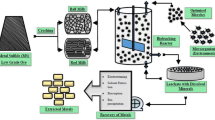With the aim of intensification, improving economic efficiency, and controlling sulfide ore heap bacterial leaching features and leaching regimes are studied for lean copper-nickel ore with the participation of a bioreagent-oxidant prepared by iron-oxidizing micro-organisms and concentrated adsorption immobilization in a separate reactor. Research established the ore size for heap leaching and an increase in metal extraction with an increase in bioreagent concentration. Use of the heap bioleaching technology developed for ore with a size of –10 mm containing 0.32% nickel and 0.11% copper makes it possible to increase nickel extraction into solution to 6.3–19.5% and copper to 5.8–24.2% with consumption of sulfuric acid lower by 4.4–14.6% compared with use of seeding ore with bacteria.


Similar content being viewed by others
References
D. E.Rawlings and B. D. Johnson (eds.), Biomining, Springer, Berlin (2007).
H. R. Watling, “The bioleaching of nickel-copper sulfides,” Hydrometallurgy, 91, 70–88 (2008).
M. Riekkola-Vanhanen, “Talvivaara black schist bioheap leaching demonstration plant,” Adv. Mater. Res., 20, No. 21, 30–33 (2007).
H. Yuan and J. Wen, “Heap bioleaching of a low grade nickel-cobalt sulfide ore,” Adv. Mater. Res., Changsha, China, 826–832 (2011).
T. Gehrke, J. Telegdi, D. Thierry, and W. Sand, “Importance of extracellular polymeric substances from Thiobacillus ferrooxidans for bioleaching,” Appl. Environ. Microbiol., 64, 2743–2747 (1998).
M. S. Gusakov, L. N. Krylova, and Zheng Zhihong, “Features of the composition and properties of sulfuric acid bacterial solutions of iron,” Proc. Int. Meeting Contemporary Methods for Process Mineralogy in Complex and Thorough Mineral Resource Treatment (Plaksinskie Chteniya – 2012), Petrozavodsk (2012), pp. 311–313.
A. Taylor, “Heap bioleaching pushing the envelope,” at: ALTA Metallurgical Services, www.altamet.com.au/wp-content/uploads/2012/12/ Heap-Bioleaching-Pushing-the-Envelope.pdf, acces. April 2003.
Xiuxia Zhang, Lijiao Qin, Congcong Huang, et al., “Study on the selection of immobilized carrier and its performance,” Chem. Indust. Eng. Prog., 30, No. 12, 2781–2786 (2011).
Zheng Zhihong, L. N. Krylova, and Sun Zhanxue, “Study of iron (II) oxidation regimes by immobilized biomass in a sulfuric acid medium,” Biotekhnologiya, No. 1, 61–69 (2015).
This study was supported by the Russian Foundation for Basic Research (Grant 16-05-06887).
Author information
Authors and Affiliations
Corresponding author
Additional information
Translated from Metallurg, No. 7, pp. 93–96, July, 2016.
Rights and permissions
About this article
Cite this article
Zhihong, Z., Krylova, L.N. & Ryabtsev, D.A. Intensification of Sulfide Copper-Nickel Ore Heap Leaching with Bioreagent-Oxidant Participation. Metallurgist 60, 745–749 (2016). https://doi.org/10.1007/s11015-016-0361-0
Received:
Published:
Issue Date:
DOI: https://doi.org/10.1007/s11015-016-0361-0




